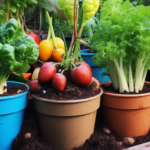Petunias are the stars of the garden, enchanting us with their vibrant colors and delightful fragrance. If you have limited outdoor space or want to add a pop of color to your patio, growing petunias in containers is a brilliant idea. These versatile and easy-to-care-for flowers thrive in pots, making them the perfect choice for container gardening. Let’s delve into some expert tips for cultivating flourishing petunias in containers that will make your outdoor space come alive with a symphony of colors.
1. Choosing the Right Container: Size Matters
When it comes to growing petunias in containers, size matters. Opt for pots that are at least 12 inches in diameter to provide enough space for the roots to spread and the plant to flourish. Larger containers also retain moisture better, reducing the need for frequent watering. Additionally, ensure that the pots have drainage holes to prevent waterlogging, which can lead to root rot.
2. The Sun-Loving Beauties: Sunlight Requirements
Petunias are sun-loving flowers that thrive in full sun conditions. When choosing a spot for your containers, select a location that receives at least six hours of direct sunlight daily. Placing the pots on a sunny windowsill or a well-lit balcony will ensure that your petunias get the sunshine they crave, resulting in an abundance of blooms.
3. The Art of Watering: Keep It Consistent
Consistent watering is crucial for the health and well-being of your petunias. Containers tend to dry out faster than garden beds, so check the soil regularly and water whenever the top inch feels dry to the touch. Avoid overwatering, as it can lead to root rot. A good rule of thumb is to water deeply until the excess water drains from the bottom of the container.
4. Feeding for Blooming Brilliance: Fertilize Wisely
To encourage blooming brilliance, fertilize your petunias every two to three weeks during the growing season. Choose a balanced, water-soluble fertilizer and follow the recommended dosage. Over-fertilization can lead to excessive foliage growth at the expense of flowers, so it’s best to stick to the guidelines provided by the manufacturer.
5. The Pruning Secret: Pinch to Perfection
Petunias have a natural tendency to become leggy as they grow. To keep them compact and bushy, practice the art of pinching. Pinch off the tips of the stems regularly, especially when the plant is young. This encourages branching and results in more flower-bearing stems. Don’t worry about hurting the plant; petunias respond well to pinching and will reward you with a fuller, more vibrant display.
6. Deadheading Delight: Remove Spent Flowers
Deadheading is a simple yet effective practice to prolong the blooming season of your petunias. As the flowers fade and wither, pinch or snip them off at the base. This prevents the plant from diverting energy into seed production and encourages it to produce more flowers instead. Regular deadheading will keep your petunias looking fresh and radiant throughout the season.
7. Frost Protection: Guard Against Chills
Petunias are tender annuals that are sensitive to frost. If you live in a region with chilly nights, keep an eye on the weather forecast and be prepared to protect your petunias when frost is predicted. Bring the pots indoors overnight or cover them with blankets or frost cloths to shield them from the cold.
8. Companion Planting: Mixing and Matching
Experiment with companion planting to create visually stunning displays in your containers. Pair petunias with complementary flowers like marigolds, lobelia, or geraniums to add texture and color contrast. Combining different varieties of petunias, such as Grandiflora, multiflora, and milliflora, can also create a captivating tapestry of blooms.
9. Pest and Disease Watch: Keep an Eye Out
While petunias are relatively resistant to pests and diseases, it’s essential to keep an eye out for any signs of trouble. Aphids, caterpillars, and fungal issues can occasionally plague these plants. Regularly inspect the leaves and stems, and if you notice any problems, take prompt action to prevent them from spreading.
10. A Dash of Mulch: Protect and Conserve
Applying a layer of organic mulch around your petunia plants offers multiple benefits. Mulch helps retain soil moisture, suppresses weed growth, and provides a layer of insulation against extreme temperatures. Organic mulches like straw, shredded leaves, or compost also enrich the soil as they break down.
In Conclusion: Flourishing Blooms in Your Hands
Growing petunias in containers is a rewarding experience that allows you to create a floral paradise in even the smallest spaces. With the right care and attention, your petunias will reward you with a symphony of colors and blooms that will brighten your days and lift your spirits. Follow these expert tips, and soon you’ll be basking in the beauty of your flourishing petunias, knowing that the magical display is a product of your green thumb and nurturing love. Happy gardening!



